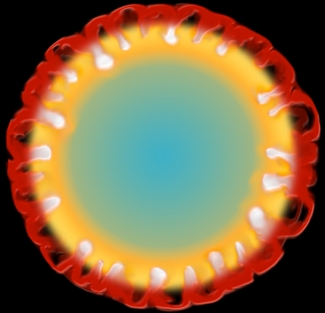For nearly 18 years, JILA Fellow Dick McCray has been studying the brightest supernova to light up Earth's night skies since the Renaissance. Known as 1987A because it appeared in the southern sky on February 23, 1987, the supernova occurred when a 10-million-year-old blue supergiant star exploded in the Large Magellanic Cloud, a galaxy located 160,000 light years from Earth.
McCray and other astrophysicists have investigated the unfolding story of 1987A in visible, ultraviolet, and X-ray wavelengths, with the goals of better understanding both the star's spectacular demise and its past history. Their observations led them to conclude that about a million years ago, the giant star lost most of its outer layers as a slow-moving stellar wind formed a vast, cool cloud of gas around the star. Then, before the star exploded, a high-speed wind blowing off the star's molten surface carved out a cavity in the gas cloud.
When the star exploded, an intense flash of ultraviolet light illuminated the edge of the cavity, highlighting a bright ring. At the same time, the explosion propelled a shock wave into the cavity toward the gas cloud. In 1991, McCray and his student Ding Luo correctly predicted that the shock wave would crash into the ring of gas around 1997, heating and illuminating denser areas of gas. By 2003, the shock wave crash had created dozens of hot spots encircling the ring's edge like a necklace of dazzling diamonds.





